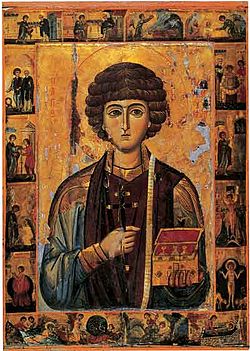Text is from The Saint Andrew Daily Missal,
unless otherwise stated.
Saint Martha.
Virgin.
Feast Day 29 July.
Semi-Double.
White Vestments.
Jesus at the house of Mary and Martha.
Date: 1927.
(Wikimedia Commons)
After having celebrated, on the 22nd of this month, the Feast of Saint Mary Magdalen, we honour today, Martha, her sister.
The daughter of noble and rich parents, she lived at Bethany, two miles from Jerusalem. "Jesus", says Saint John, "loved Martha and her sister Mary and Lazarus," wherefore He preferred to dwell at their house when He was in Judea. There He spent the days which preceded His death.
Martha, who was the eldest, therefore often had the honour of being the hostess of Jesus (Gospel, Communion), The Divine Spouse, to Whom she had Consecrated her Virginity (Epistle). While busy with serving Jesus, she requested Him to bid Mary help her. And Jesus, without blaming her for ministering to His wants, made her understand that certain Souls, called by God, choose a still better part, since they commence on Earth what all shall do in Heaven.
Active life, with all its labours and fatigues endured for the sake of Christ, Whom we serve in our neighbour, is very meritorious; "happy, however, is the home where Mary causes the complaint of Martha" [Saint Bernard of Clairvaux: Sermon III of The Assumption] and refuses to take away from Prayer a life which ordinary occupations might appear to claim.
God is indeed the author of all Grace and wishes to be recognised as such; and contemplative life, which puts Souls in direct contact with Him, assures their personal Sanctification more fully and obtains more efficaciously the Graces by which a Christian Apostleship becomes fruitful.
Let us esteem at its just value the position that Jesus reserves to Mary, and, if He calls us to share in Martha's solicitude, let us endeavour, like the Saints, to make up by the spirit of Prayer, for what is wanting in active life.
Mass: Dilexísti.
Commemoration of Saints Felix, Simplicius, Faustinus and Beatrice. Martyrs.


THE SAINT ANDREW DAILY MISSAL
Available (in U.K.) from
Available (in U.S.A.) from














.jpg)









.jpg)









